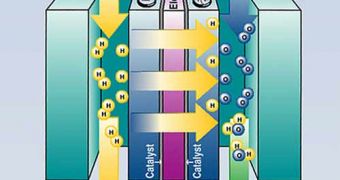Although not very obvious, there is a link between termites, cows and cars: bacteria. Some of these little critters are helping cows and termites digest cellulose, and some can produce electrical current and could be used in fuel cells that could power up future ecological cars.
A group of researchers at Penn State University came up with the idea of carefully pairing these bacteria in a fuel cell that consumes cellulose and produces electricity. This could mean future cars able to eat biodegradable substances and produce energy, much like living organisms do.
"We have gotten microbial fuel cells to work with all kinds of biodegradable substances including glucose, wastewater and other organic wastes," says John M. Regan, assistant professor of environmental engineering. "But, cellulose is tricky. There is no known microbe that can degrade cellulose and reduce the anode.
"We overcame this by putting together a microbe that can degrade and ferment cellulose and an anode-reducing bacterium that can live off the fermentation products," he says.
In fuel cells, bacteria pass electrons to an anode, from which they flow through a wire to the cathode, producing an electric current. In the process, the bacteria consume organic matter in the water or sediment.
Regan, along with Thomas E. Ward, research associate and Zhiyong Ren, graduate student, looked at Clostridium cellulolyticum, a bacterium that ferments cellulose, and Geobacter sulfurreducens, an electroactive bacterium. They are both anaerobic, able to live in oxygen deprived environments, and by combining the former's ability to produce acetate, ethanol and hydrogen, with the latter's to consume some of the acetate and ethanol, the scientists could create a process that effectively transforms cellulose into electricity.
The team developed a two-chamber fuel cell that produced a maximum of 150 milliwatts per square meter. "We achieved a low power density because of the two chamber system," says Regan. "Current fuel cell designs produce about ten times that."
With a few improvements, this type of applications could soon find their way into mass produced cars, that will eat plants instead of fossil fuels.

 14 DAY TRIAL //
14 DAY TRIAL //